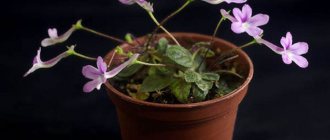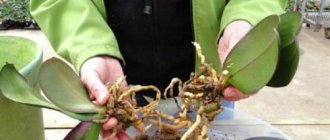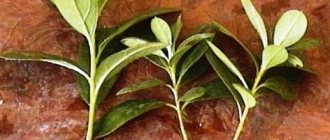How to propagate an orchid at home: methods
There are several ways in which you can propagate an orchid:
- Seeds
- Cuttings
- Children
- Dividing the root
In some countries, such as Thailand, you can find flasks with ready-made seedlings that look like decorative decorations for your home. Similar products can be purchased at a flower shop. In this case, practically nothing needs to be done. It is enough to remove the seedlings from the flask and root them. Which also requires some skill and patience. If you don’t have such children, but can boast of a recently acquired plant that is blooming, we recommend waiting a little.
It is best to start propagation in the spring from a ready-made adult bush. You can get a new plant by dividing the roots or by bulbs. You can also use root or stem babies, but they appear only in conditions where the room is very hot and has high humidity. We do not recommend cutting off the roots of children, because in this case both plants suffer: young and adult. The best option is to divide the bush, as well as the children that form on the stems.
Orchid flowers
Types of children
Depending on the location, the following types of children are distinguished:
- basal;
- located on the peduncle;
- developed in the leaf axil or stem.
Most often, the development of shoots in phalaenopsis is observed on the peduncle. This may be due both to the creation of favorable conditions and to the approaching death of the mother plant. In most cases, they manage to develop into an independent plant without outside help.
The mechanism of development of root and stem children is somewhat different. It is not the dormant bud that participates in their formation, but the meristem tissue of the plant. Experienced gardeners associate the appearance of such shoots with the approaching death of the plant. Their appearance is also possible due to injuries to the trunk, death of a growing point, during a prolonged drought, or when a peduncle forms from the center of the rosette. Children that develop on the trunk or in the leaf axil may not produce roots for a long time, so their rooting is somewhat difficult.
Stem baby phalaenopsis orchid
Orchid: propagation at home by cuttings
Some types of orchids are propagated by cuttings.
Instructions:
- In order to propagate in this way, it is necessary to cut off the side stem and cut it into pieces 10-15 cm long.
- It is necessary that there are at least two dormant buds on one piece. Next, you need to take light soil, moisten it and place these pieces of the plant on the soil.
- Cover everything with cling film or a glass cover and constantly spray the pieces.
- After some time, roots and new sprouts will appear from the cuttings, that is, from the dormant buds.
Orchid propagation by cuttings
Propagation of orchids with peduncles at home
One of the least traumatic methods of division for a plant is propagation by peduncles. Mainly used when plants bloom regularly.
Instructions:
- After the plant has flowered, the peduncle is cut off at the very root. Next, this stem is cut into pieces 3-4 cm long.
- The cut area is treated with charcoal. These pieces of the plant are laid out on moist, light soil and covered. A mini-greenhouse is constructed using a plastic bottle or plastic film.
- Rooting and growth of children occurs at a temperature of 25-28 degrees. Therefore, we recommend that you control the temperature and humidity in this mini-greenhouse and constantly spray the plant.
- Do not let the soil dry out or any stem pieces dry out. After some time, new children and roots will appear.
Reproduction by peduncles
Mistakes when raising children
- The main mistake gardeners make when forcing children is failure to comply with the temperature regime . If you keep an orchid treated with phytohormones at a temperature below +25°C, then most likely, not a baby will form, but a new peduncle.
- Some gardeners practice orchid propagation by rooting the cut top, in the hope that new growth will appear on the remaining stump. This is a rather risky experiment. There is a high probability of ruining a healthy plant - neither the top will take root, nor the children will hatch.
Orchid: propagation at home by children
Reproduction by children can be carried out in several ways. The fact is that in conditions of high humidity and temperature, children produce strong plants on their own. They can be located both on the peduncle and on the side stems. In order for the branch to develop strong roots, it is necessary to constantly spray it with a sprayer.
As soon as the roots appear, the baby is cut off and planted in prepared soil. If your plant does not have children, then you can stimulate their growth. For this, hormonal paste is most often used; it can be purchased at any flower shop.
Instructions for raising children with hormonal paste:
- You need to examine the peduncle as well as the side stems for the presence of white membranes. Now, using a thin blade, you carefully remove this film and use tweezers to pull it down.
- You will see a green dot on the stem or peduncle itself. This is a dormant bud from which children can grow.
- Next, you need to use a toothpick to treat this particular point with hormonal paste. Treatment is carried out once every 4 days. A total of 4-6 treatments are necessary. After them, the sleeping bud usually awakens and a baby grows from it.
- As soon as you see that a new sprout is hatching from this green dot, you need to constantly treat it with a growth stimulator, as well as with water from a spray bottle.
- After 4 leaves appear on the baby, as well as two strong roots, it can be cut off and transplanted into a prepared pot.
Orchid propagation by children
Further care of the plant
After the final transplant, you need to take care of the baby like an adult plant. It is important to water the plant properly so that it has enough moisture, but not a very large amount. After the first watering, this plant should be watered again only after the substrate has completely dried.
For a certain time, it is possible to add a small amount of growth stimulants and fertilizers to the irrigation water. Be sure to guarantee the young plant optimal lighting and a comfortable temperature .
It is important to know that there are other ways to propagate an orchid, namely by peduncles, roots, cuttings, and information about propagating the Dendrobium nobile orchid at home may also be useful.
Orchid propagation by rooting in water
Many people have heard that an orchid can be propagated in the classical way, that is, by rooting or propagation in water. To do this, you need to use an already faded sprout, that is, the peduncle itself.
Instructions:
- You will need to cut it directly at the roots and place it in a bottle, the neck of which must be cut 5 cm from the top.
- Pour water, it should be purified, soft, filtered. It is best to melt, add an activated carbon tablet to it. This will help disinfect the sprout to prevent the spread and reproduction of diseases.
- Place the peduncle about 4-5 cm into the water. Now you need to start waking up the sleeping bud.
- You need to use a razor or blade to carefully cut off the scales that are located above the bud. Lubricate the bud itself with a cytokinin mixture, which is sold at any flower shop.
- Now you need to treat with this ointment every week for a month. Be sure to change the liquid in the bottle once a week.
- Remember, temperature is very important, as well as humidity. You will not get any babies or new shoots if the room temperature is below 25 degrees. The optimal temperature is 28-30 degrees. This temperature regime is suitable for flower propagation.
- The ideal period for propagation is after flowering. It is then that the plant is set up to reproduce and all efforts will be directed towards raising children.
Rooting in water
Orchid propagation by roots
Propagation of orchids by roots is suitable even for beginners, because the method is quite simple and does not require more time or effort.
Instructions:
- After flowering, you need to remove the plants from the soil and free them from soil. You can rinse under running water to leave the roots bare.
- Next, you need to sterilize the knife, pruning shears, and divide the plant, that is, the roots themselves, into three parts.
- Be sure to apply a little charcoal to the cut area. Now you need to transplant each part into a separate container with new soil.
- Spray the plants morning and evening until you get new leaves and good roots.
Reasons why plants do not reproduce:
- This is possible if you use an initially unhealthy plant. If an orchid has a strange color of leaves, black roots, and also has mucus on them, it is useless to use such a plant for propagation.
- The only method suitable for propagating diseased plants is germination in water by cutting off the peduncle.
- It is necessary to sterilize the cut areas; for this, wood ash or charcoal is used. Never place plants in direct sunlight. This is dangerous and you will not get new babies and good roots from the cuttings.
- Be sure to maintain optimal temperature and humidity conditions. The ideal humidity for orchids is 50-80%, and the temperature is 28-30 degrees.
Root division
Features of care
The baby develops on the mother plant for six months. During this time she had :
- Leaves grow in the amount of 3-5 pieces;
- And roots develop.
For good growth, it is necessary to properly care for the baby orchid.
When the roots reach a length of 5 cm, then such a baby can already be separated from the main bush.
If the baby takes longer to develop, then it is missing some components and it is necessary to reconsider the care of the plant in order to find the error and correct it.
to feed the flower every week with orchid fertilizer with a large amount of nitrogen.
IMPORTANT! Fertilizers are applied only after watering to wet roots, so as not to burn the velamen.
The baby is ready for separation if:
- Its leaves are already collected in a rosette of 3-5 leaves;
- And the roots reached a length of 5 cm.
This is the optimal size when it is planted in a separate container , separated from the mother plant. In this case, the container is selected so that it does not “grow”. Children of the same variety, planted in one container, look very beautiful. They look especially exotic at the time of flowering.
Orchid propagation by seeds
You can propagate an orchid by seeds. This is one of the most labor-intensive and costly methods, which requires a lot of time. Getting seeds is easy. In order to get the seeds, you need to pollinate the orchid flower with a toothpick. If you are not ready to do this, you can use already purchased seeds. You need to open the boxes, remove the seeds from them, and prepare a special paste in which your seeds will grow.
Recipe for making paste for sprouting seeds:
- You need a sachet of agar-agar powder, 12 g of glucose and a few drops of phosphoric acid, calcium carbonate and 210 ml of purified water.
- Pour agar-agar with a small amount of water. Let it sit until it turns out something like jelly.
- Boil the remaining water and add the swollen agar-agar. Enter fructose, calcium carbonate, glucose, acid. You should get a substance without crystals.
- Jars with screw caps must be thoroughly sterilized. After that, wipe them with alcohol and let them dry well. Remember, everything must be absolutely sterile.
- Now pour 50 ml of the prepared solution into each jar. Screw on the lids and leave for about a week. Observe what happens to the solution.
- If mold has grown on the surface, you will need to discard this nutrient. If everything is in order, you followed all the instructions, then the solution will not show any signs of mold.
- Now you need to pour a 1% bleach solution onto the seeds. Leave for 15 minutes to disinfect the seeds. Remember to shake the container constantly to ensure the seeds are completely covered with the bleach solution.
- Take a sterile syringe and remove the needle from it. Use a syringe to suck out about 2 ml of the solution with seeds, pour it into the prepared solution through the lid, making a small hole.
- Close the container and place the jars in the greenhouse. After about six months you will get small sprouts, this is if your seeds germinate.
- Now you need to pour another 50 ml of warm, purified water into this jar and add 3 drops of 1% findazole. Leave the extracted sprouts in the prepared solution for 20 minutes.
- This will stimulate their root system. Now these sprouts can be transplanted into a container for further germination. You need to prepare a mixture of soil and bark. Place it in a pot, now add a few crushed fern roots and a little crushed activated carbon.
- Next, take a soft brush, which lifts the sprouted seeds and with its help everything is transferred to the nutritious soil. Only after six months you will be able to transplant the sprouts to a permanent place. Unfortunately, such a plant will not bloom earlier than 5 years after germination and planting in a permanent place.
Orchid blooms
How to grow and root roots
When the bud has awakened, you need to know how to grow a baby orchid from a peduncle. To do this, it is necessary to ensure that it grows roots of the required length. There is an opportunity to accelerate their growth.
Aerial orchid roots: transplantation and other options
To do this, the baby Phalaenopsis must be moistened with stimulating solutions: Kornevin or Heteroauxin. It is possible to also use natural remedies for this purpose: a solution of honey in water or aloe juice.
In order to enhance root growth, you can use sphagnum moss. It must be moistened in a solution of one of the stimulants and attached to the baby with a thread in the place where the roots should grow.
Note! It is necessary to water daily using a spray bottle. When the roots begin to grow, the moss is removed. If this is not done, waterlogging may occur.
After the roots grow to 4-6 cm, the baby must be separated. This can be done by cutting off a part of the peduncle several centimeters long along with the sprout.
Sometimes several shoots form on one branch. In order to cut them off, you can use sharp scissors or a scalpel, carefully separating the baby from the peduncle less than 1 cm above and below its location.
Important! It is recommended to disinfect tools before work. To do this, just dip them in boiling water.
Now you need to plant and root the sprouts. To do this, it is recommended to do the following:
- The cutting area is lubricated with coal dust for disinfection.
- For planting, you need to prepare plastic bottles with the top cut off. Their depth should be such that the roots fit freely. Several holes are made at the bottom to provide drainage.
- Plants need to be kept in water so that it covers the roots. Do this for 20 minutes. This is necessary so that they do not dry out when they are placed in plastic pots.
- Now you need to prepare the substrate in which the Cattleya or Phalaenopsis babies will grow. It is prepared in a separate container. A small piece of charcoal is placed there, crushed bark is added, then sphagnum moss is added in small pieces.
- After this, you need to plant the children in plastic containers, cutting them so that their depth matches the root system. Then the substrate is added so that it covers the roots.
cut baby
When the root system develops and the orchids take root, they can be planted in permanent places.
Orchid propagation at home: tips
General tips:
- An orchid can only be propagated if it has been in full bloom for more than 2 years. This is when the plant is considered healthy, mature and suitable for propagation. Otherwise, you will not get results, or worse, you may ruin the main plant.
- There are also defined standards in which stimulation must be carried out. Rooting work is best done in February.
- In this case, you need to plant a flower that has bloomed directly on the western or eastern side, where there is not much light.
- You also need to shade the leaves and not allow sunlight to reach the flowers. During the day, the temperature should be at 28 degrees; the temperature at night can be reduced to at least 18 degrees.
- In this case, watering is reduced to a minimum, fertilizing is not applied until you receive a bud. You will have to spend about a month and a half waking up the sleeping kidney.
- As soon as you see that the plant has appeared, you need to move the flower to the shade. Because it is impossible for the baby to be exposed to direct sunlight. Now you can fully water the plant and add bait that will feed the plant with useful substances.
- Remember that the process of germination and growing a baby is quite long. It will take you about six months to get a full-fledged baby that can be transplanted to a new place. It is in six months that approximately 3 leaves and roots 3 cm long appear.
- Now all you have to do is carefully separate the plant from the main one, that is, the mother one, and replant it in a pot.
Orchid flowers
Despite the apparent difficulties, growing and propagating orchids is simple, provided you follow the instructions and follow all the rules and recommendations. Do not forget to regularly water and feed young plants, as well as rooted cuttings.
Preliminary preparation
In order for separation and planting to proceed without complications for the orchid, you need to adhere to some rules.
Growing a shoot and caring for it
If the shoot appears on the flower shoot, there is no need to wait for the roots to develop. It is enough to wait until 3-4 leaf plates grow. After this, it is allowed to separate the process. The procedure is carried out with a sharp blade, otherwise the process will be damaged. Before cutting, the instrument must be treated with a disinfectant.
After separation, children perform the following actions:
- The cut areas on both the peduncle and the separated part are treated with crushed coal (can be replaced with cinnamon).
- Let the baby dry for 24 hours. Then plant it in a fine fraction substrate. In this soil, the young plant will take root. At this time, the lower pair of leaves turn yellow. There is no need to worry, this is normal. But you can’t cut them off yourself either.
- In order for the shoot to take root quickly and painlessly, it is recommended to place them in a mini-greenhouse. It maintains a temperature regime of +23-+25 degrees. The root system on a young orchid takes a long time to form.
- To speed up this process, the plant can be treated with phytohormones, and the soil can be sprayed with a growth stimulant (the most popular and affordable drug is Epin).
Flower growers do not recommend treating leaf blades with phytohormones, since the leaves will begin to grow, while the development of roots will remain in place.Another way to stimulate root growth is to place the container with the orchid close to water. To do this, you can place a flowerpot with a plant on moistened moss.
Some gardeners do not place the baby in the substrate, but put it in foam.
- Take a low, flat piece of foam and make 2-3 small holes in it.
- Place a young orchid in one hole, and then place the foam on the water. For this they say a transparent container (you can even take a cut-off bottle).
- Cover the entire structure with polyethylene. Warmth and moisture will stimulate the development of the phalaenopsis root system.
Future landing site
First, prepare a container for planting. Phalaenopsis roots take part in photosynthesis, so the supply of light is important for them. It is for this reason that the optimal pot for a baby orchid will be transparent. You can use a plastic pot, or sometimes glass vases are used; they add grace to this noble flower.
You need to place the pot with a young plant in a well-lit place, but at the same time protect the delicate roots of the plant from direct sunlight.
As soon as the container for planting is ready, we proceed to preparing the substrate. It should be as nutritious as possible for the baby to quickly recover and revive. The orchid loves moist air, so the recommended recipe is as follows:
- pine bark;
- sphagnum moss;
- charcoal.
The ratio of components is 5:2:1. The ingredients can be taken in equal quantities, then the mixture will have medium or high moisture capacity.
The optimal level of air humidity is 65-70%, and its temperature is 21-23 degrees.











